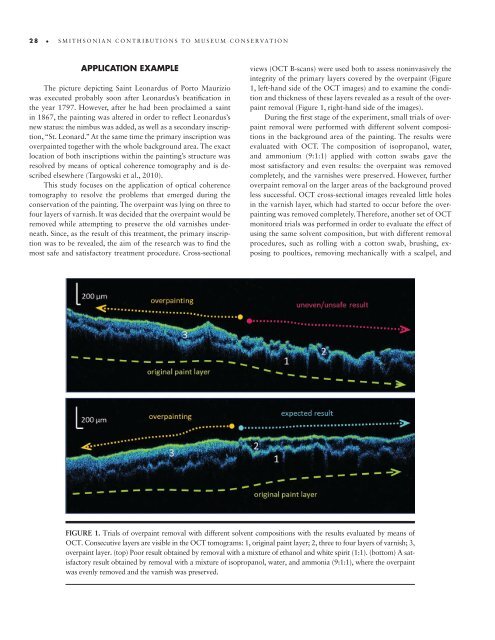Create successful ePaper yourself
Turn your PDF publications into a flip-book with our unique Google optimized e-Paper software.
28 • smithsonian contributions to museum conservation<br />
APPLICATION EXAMPLE<br />
The picture depicting Saint Leonardus <strong>of</strong> Porto Maurizio<br />
was executed probably soon after Leonardus’s beatification in<br />
<strong>the</strong> year 1797. However, after he had been proclaimed a saint<br />
in 1867, <strong>the</strong> painting was altered in order to reflect Leonardus’s<br />
new status: <strong>the</strong> nimbus was added, as well as a secondary inscription,<br />
“St. Leonard.” At <strong>the</strong> same time <strong>the</strong> primary inscription was<br />
overpainted toge<strong>the</strong>r with <strong>the</strong> whole background area. The exact<br />
location <strong>of</strong> both inscriptions within <strong>the</strong> painting’s structure was<br />
resolved by means <strong>of</strong> optical coherence tomography and is described<br />
elsewhere (Targowski et al., 2010).<br />
This study focuses on <strong>the</strong> application <strong>of</strong> optical coherence<br />
tomography to resolve <strong>the</strong> problems that emerged during <strong>the</strong><br />
conservation <strong>of</strong> <strong>the</strong> painting. The overpaint was lying on three to<br />
four layers <strong>of</strong> varnish. It was decided that <strong>the</strong> overpaint would be<br />
removed while attempting to preserve <strong>the</strong> old varnishes underneath.<br />
Since, as <strong>the</strong> result <strong>of</strong> this treatment, <strong>the</strong> primary inscription<br />
was to be revealed, <strong>the</strong> aim <strong>of</strong> <strong>the</strong> research was to find <strong>the</strong><br />
most safe and satisfactory treatment procedure. Cross- sectional<br />
views (OCT B- scans) were used both to assess noninvasively <strong>the</strong><br />
integrity <strong>of</strong> <strong>the</strong> primary layers covered by <strong>the</strong> overpaint (Figure<br />
1, left- hand side <strong>of</strong> <strong>the</strong> OCT images) and to examine <strong>the</strong> condition<br />
and thickness <strong>of</strong> <strong>the</strong>se layers revealed as a result <strong>of</strong> <strong>the</strong> overpaint<br />
removal (Figure 1, right- hand side <strong>of</strong> <strong>the</strong> images).<br />
During <strong>the</strong> first stage <strong>of</strong> <strong>the</strong> experiment, small trials <strong>of</strong> overpaint<br />
removal were performed with different solvent compositions<br />
in <strong>the</strong> background area <strong>of</strong> <strong>the</strong> painting. The results were<br />
evaluated with OCT. The composition <strong>of</strong> isopropanol, water,<br />
and ammonium (9:1:1) applied with cotton swabs gave <strong>the</strong><br />
most satisfactory and even results: <strong>the</strong> overpaint was removed<br />
completely, and <strong>the</strong> varnishes were preserved. However, fur<strong>the</strong>r<br />
overpaint removal on <strong>the</strong> larger areas <strong>of</strong> <strong>the</strong> background proved<br />
less successful. OCT cross- sectional images revealed little holes<br />
in <strong>the</strong> varnish layer, which had started to occur before <strong>the</strong> overpainting<br />
was removed completely. Therefore, ano<strong>the</strong>r set <strong>of</strong> OCT<br />
monitored trials was performed in order to evaluate <strong>the</strong> effect <strong>of</strong><br />
using <strong>the</strong> same solvent composition, but with different removal<br />
procedures, such as rolling with a cotton swab, brushing, exposing<br />
to poultices, removing mechanically with a scalpel, and<br />
FIGURE 1. Trials <strong>of</strong> overpaint removal with different solvent compositions with <strong>the</strong> results evaluated by means <strong>of</strong><br />
OCT. Consecutive layers are visible in <strong>the</strong> OCT tomograms: 1, original paint layer; 2, three to four layers <strong>of</strong> varnish; 3,<br />
overpaint layer. (top) Poor result obtained by removal with a mixture <strong>of</strong> ethanol and white spirit (1:1). (bottom) A satisfactory<br />
result obtained by removal with a mixture <strong>of</strong> isopropanol, water, and ammonia (9:1:1), where <strong>the</strong> overpaint<br />
was evenly removed and <strong>the</strong> varnish was preserved.
















